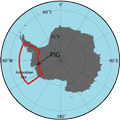 The Pine Island Glacier in West Antarctica is thinning four times faster than 10 years ago, a new study(*) of satellite measurements shows. Since 1994, the central portion of the glacier has thinned by as much as 90 metres, and the ice surface is currently lowering by 16 metres a year. At this rate of thinning, the glacier could disappear in 100 years, instead of the 600 years earlier estimates had suggested. The BBC report includes an excellent video, and focuses on the implications for sea level rise:
The Pine Island Glacier in West Antarctica is thinning four times faster than 10 years ago, a new study(*) of satellite measurements shows. Since 1994, the central portion of the glacier has thinned by as much as 90 metres, and the ice surface is currently lowering by 16 metres a year. At this rate of thinning, the glacier could disappear in 100 years, instead of the 600 years earlier estimates had suggested. The BBC report includes an excellent video, and focuses on the implications for sea level rise:
One of the authors, Professor Andrew Shepherd of Leeds University, said that the melting from the centre of the glacier would add about 3cm to global sea level.
“But the ice trapped behind it is about 20-30cm of sea level rise and as soon as we destabilise or remove the middle of the glacier we don’t know really know what’s going to happen to the ice behind it,” he told BBC News. “This is unprecedented in this area of Antarctica. We’ve known that it’s been out of balance for some time, but nothing in the natural world is lost at an accelerating exponential rate like this glacier.”
Unlike Greenland, where surface melting adds to losses caused by warming oceans, in West Antarctica it’s thought that warm ocean currents (specifically the Upper Circumpolar Deep Water, which is 3ºC warmer than surface water in the region) are being channelled in under the PIG ice shelf, helped by the large trough the glacier carved in the sea floor during previous glacial maxima. Given concerns about the stability of the West Antarctic ice sheet as the world warms and sea level rises, the words “exponential rate” sound particularly ominous…
(*) Wingham, D.J., D.W. Wallis, and A. Shepherd (2009), Spatial and temporal evolution of Pine Island Glacier thinning, 1995-2006, Geophys. Res. Lett., doi:10.1029/2009GL039126, in press.

Wow. Insane.
Oh!
🙁
I guess we shouldn’t be surprised.